Financial Accounting: West Ltd's Financial Analysis & AASB 138
VerifiedAdded on 2022/10/12
|12
|2780
|13
Homework Assignment
AI Summary
This assignment analyzes the financial accounting practices of West Ltd, a company in the fishing industry, focusing on the application of AASB 138 regarding intangible assets and the capitalization of expenses. The analysis explores the company's operations, including its brand image, environmental responsibility, and the impact of its actions on its financial position. The assignment examines the potential benefits and costs associated with capitalizing expenses, particularly those related to the company's association with the ship 'Steve Irwin' and its efforts to maintain a positive public image. The analysis delves into the assumptions made, the accounting standards followed, and the impact on the company's net asset position. It also considers the importance of aligning accounting policies with the Australian Accounting Standards Board and the implications of recognizing intangible assets. The conclusion emphasizes the feasibility of capitalizing expenses that yield future economic benefits and the importance of consistent application of accounting standards to ensure accurate financial reporting.
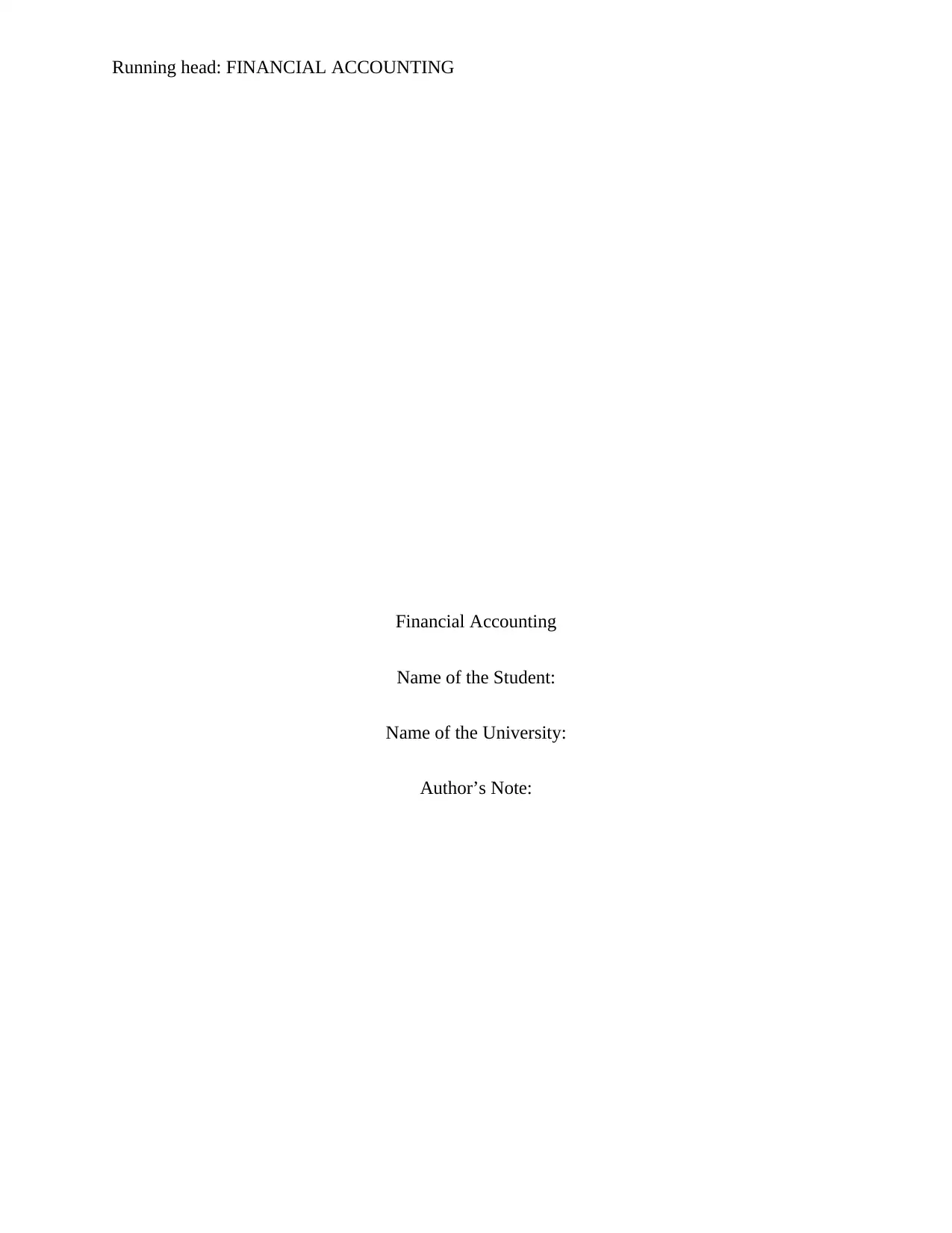
Running head: FINANCIAL ACCOUNTING
Financial Accounting
Name of the Student:
Name of the University:
Author’s Note:
Financial Accounting
Name of the Student:
Name of the University:
Author’s Note:
Paraphrase This Document
Need a fresh take? Get an instant paraphrase of this document with our AI Paraphraser
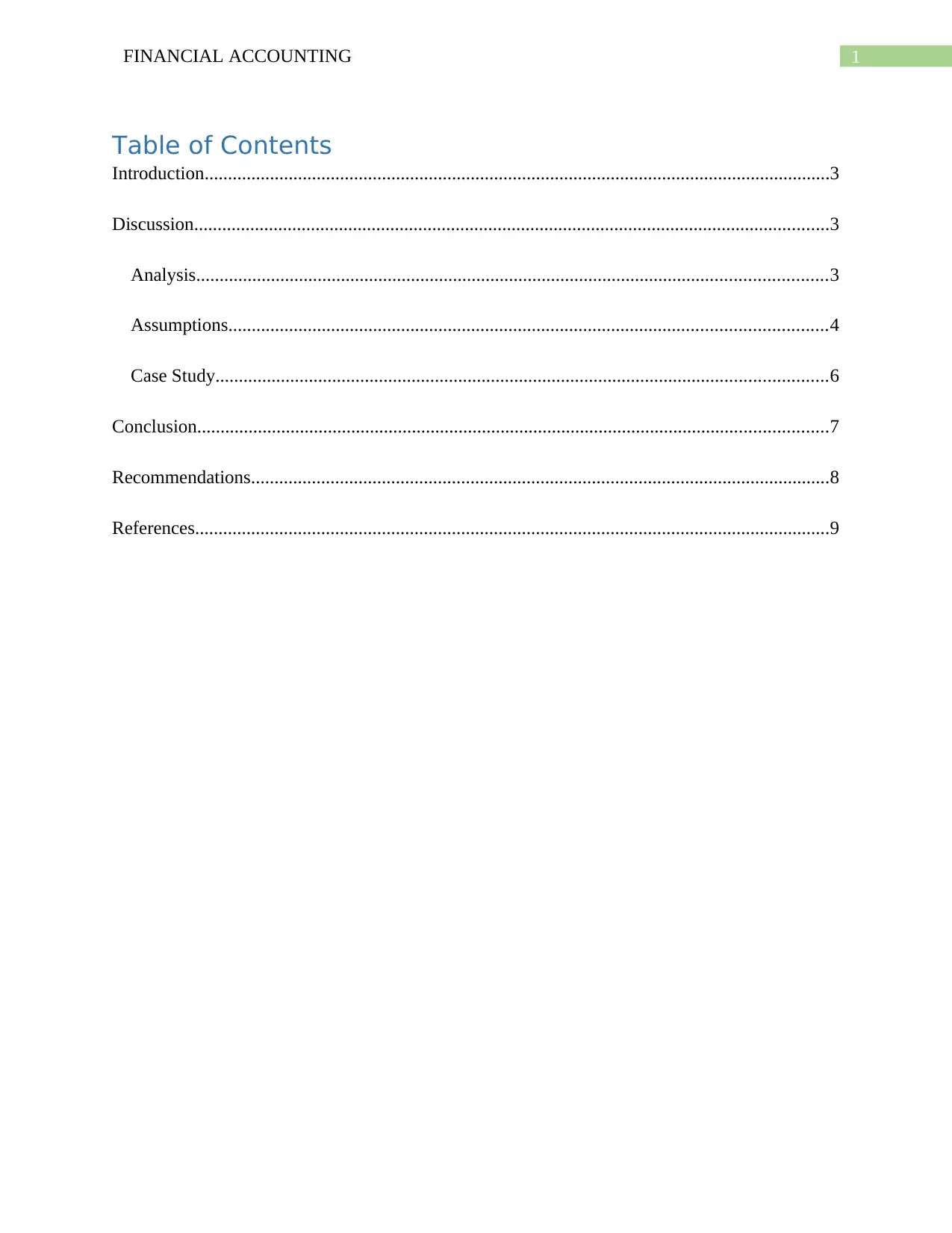
1FINANCIAL ACCOUNTING
Table of Contents
Introduction......................................................................................................................................3
Discussion........................................................................................................................................3
Analysis.......................................................................................................................................3
Assumptions................................................................................................................................4
Case Study...................................................................................................................................6
Conclusion.......................................................................................................................................7
Recommendations............................................................................................................................8
References........................................................................................................................................9
Table of Contents
Introduction......................................................................................................................................3
Discussion........................................................................................................................................3
Analysis.......................................................................................................................................3
Assumptions................................................................................................................................4
Case Study...................................................................................................................................6
Conclusion.......................................................................................................................................7
Recommendations............................................................................................................................8
References........................................................................................................................................9
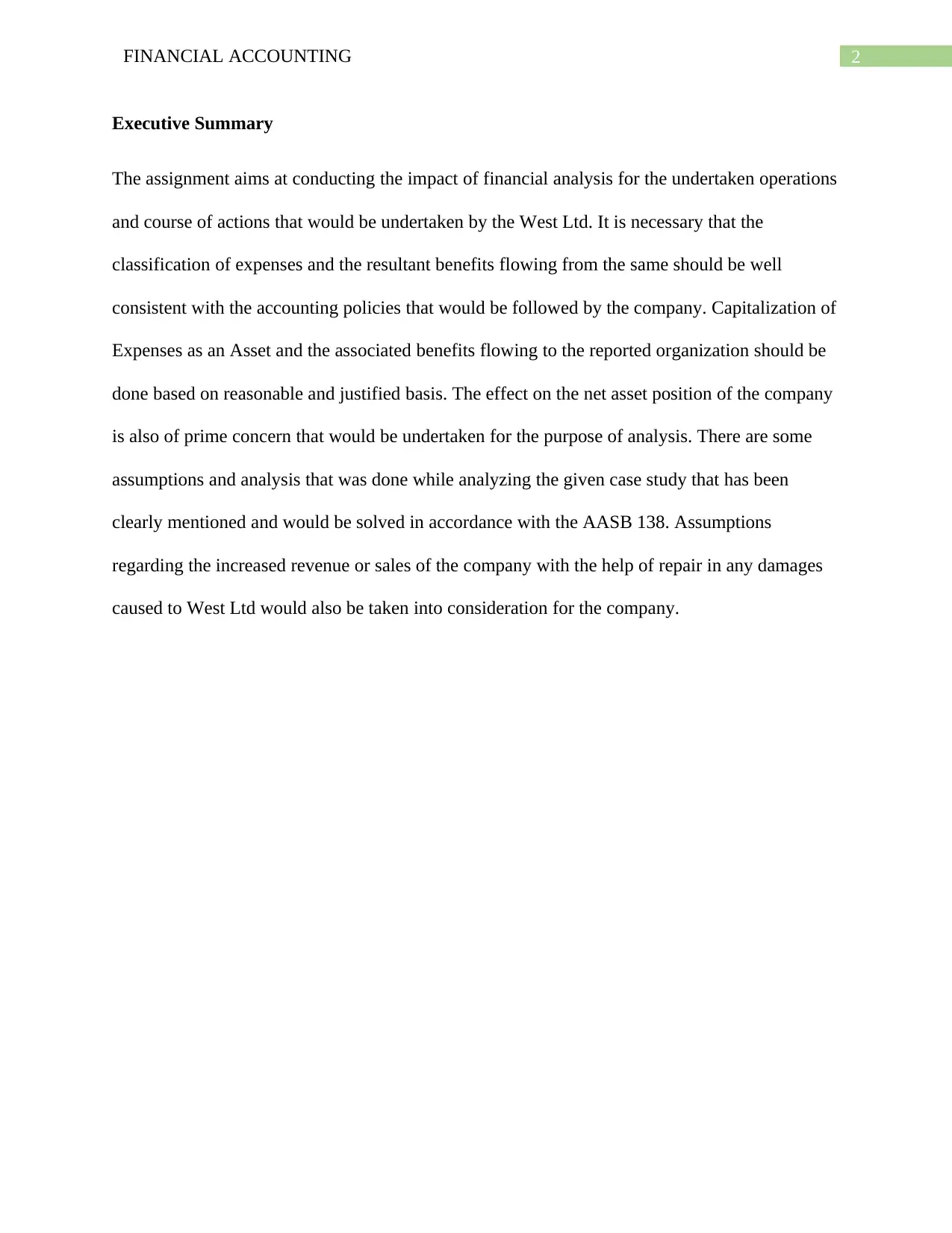
2FINANCIAL ACCOUNTING
Executive Summary
The assignment aims at conducting the impact of financial analysis for the undertaken operations
and course of actions that would be undertaken by the West Ltd. It is necessary that the
classification of expenses and the resultant benefits flowing from the same should be well
consistent with the accounting policies that would be followed by the company. Capitalization of
Expenses as an Asset and the associated benefits flowing to the reported organization should be
done based on reasonable and justified basis. The effect on the net asset position of the company
is also of prime concern that would be undertaken for the purpose of analysis. There are some
assumptions and analysis that was done while analyzing the given case study that has been
clearly mentioned and would be solved in accordance with the AASB 138. Assumptions
regarding the increased revenue or sales of the company with the help of repair in any damages
caused to West Ltd would also be taken into consideration for the company.
Executive Summary
The assignment aims at conducting the impact of financial analysis for the undertaken operations
and course of actions that would be undertaken by the West Ltd. It is necessary that the
classification of expenses and the resultant benefits flowing from the same should be well
consistent with the accounting policies that would be followed by the company. Capitalization of
Expenses as an Asset and the associated benefits flowing to the reported organization should be
done based on reasonable and justified basis. The effect on the net asset position of the company
is also of prime concern that would be undertaken for the purpose of analysis. There are some
assumptions and analysis that was done while analyzing the given case study that has been
clearly mentioned and would be solved in accordance with the AASB 138. Assumptions
regarding the increased revenue or sales of the company with the help of repair in any damages
caused to West Ltd would also be taken into consideration for the company.
⊘ This is a preview!⊘
Do you want full access?
Subscribe today to unlock all pages.

Trusted by 1+ million students worldwide
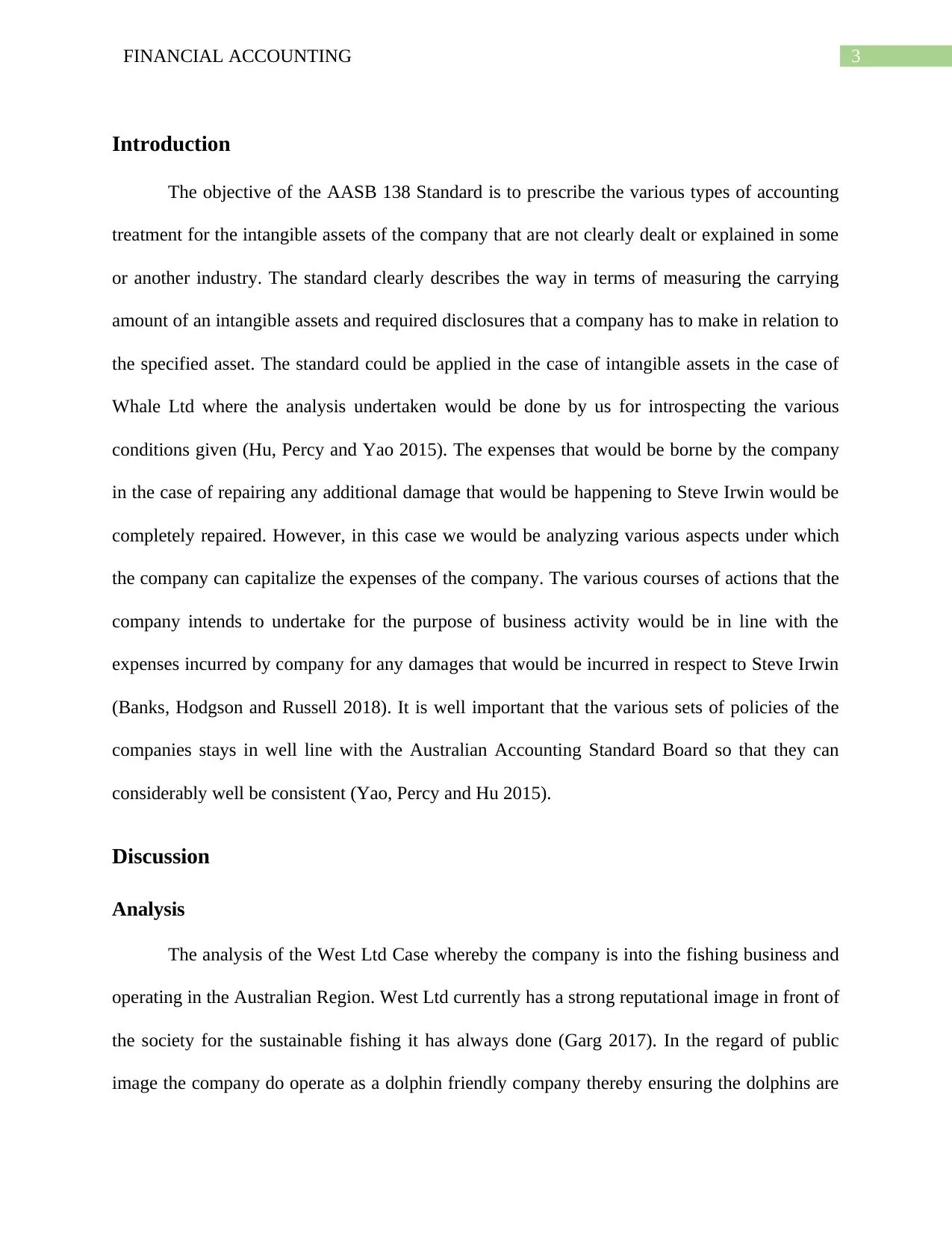
3FINANCIAL ACCOUNTING
Introduction
The objective of the AASB 138 Standard is to prescribe the various types of accounting
treatment for the intangible assets of the company that are not clearly dealt or explained in some
or another industry. The standard clearly describes the way in terms of measuring the carrying
amount of an intangible assets and required disclosures that a company has to make in relation to
the specified asset. The standard could be applied in the case of intangible assets in the case of
Whale Ltd where the analysis undertaken would be done by us for introspecting the various
conditions given (Hu, Percy and Yao 2015). The expenses that would be borne by the company
in the case of repairing any additional damage that would be happening to Steve Irwin would be
completely repaired. However, in this case we would be analyzing various aspects under which
the company can capitalize the expenses of the company. The various courses of actions that the
company intends to undertake for the purpose of business activity would be in line with the
expenses incurred by company for any damages that would be incurred in respect to Steve Irwin
(Banks, Hodgson and Russell 2018). It is well important that the various sets of policies of the
companies stays in well line with the Australian Accounting Standard Board so that they can
considerably well be consistent (Yao, Percy and Hu 2015).
Discussion
Analysis
The analysis of the West Ltd Case whereby the company is into the fishing business and
operating in the Australian Region. West Ltd currently has a strong reputational image in front of
the society for the sustainable fishing it has always done (Garg 2017). In the regard of public
image the company do operate as a dolphin friendly company thereby ensuring the dolphins are
Introduction
The objective of the AASB 138 Standard is to prescribe the various types of accounting
treatment for the intangible assets of the company that are not clearly dealt or explained in some
or another industry. The standard clearly describes the way in terms of measuring the carrying
amount of an intangible assets and required disclosures that a company has to make in relation to
the specified asset. The standard could be applied in the case of intangible assets in the case of
Whale Ltd where the analysis undertaken would be done by us for introspecting the various
conditions given (Hu, Percy and Yao 2015). The expenses that would be borne by the company
in the case of repairing any additional damage that would be happening to Steve Irwin would be
completely repaired. However, in this case we would be analyzing various aspects under which
the company can capitalize the expenses of the company. The various courses of actions that the
company intends to undertake for the purpose of business activity would be in line with the
expenses incurred by company for any damages that would be incurred in respect to Steve Irwin
(Banks, Hodgson and Russell 2018). It is well important that the various sets of policies of the
companies stays in well line with the Australian Accounting Standard Board so that they can
considerably well be consistent (Yao, Percy and Hu 2015).
Discussion
Analysis
The analysis of the West Ltd Case whereby the company is into the fishing business and
operating in the Australian Region. West Ltd currently has a strong reputational image in front of
the society for the sustainable fishing it has always done (Garg 2017). In the regard of public
image the company do operate as a dolphin friendly company thereby ensuring the dolphins are
Paraphrase This Document
Need a fresh take? Get an instant paraphrase of this document with our AI Paraphraser
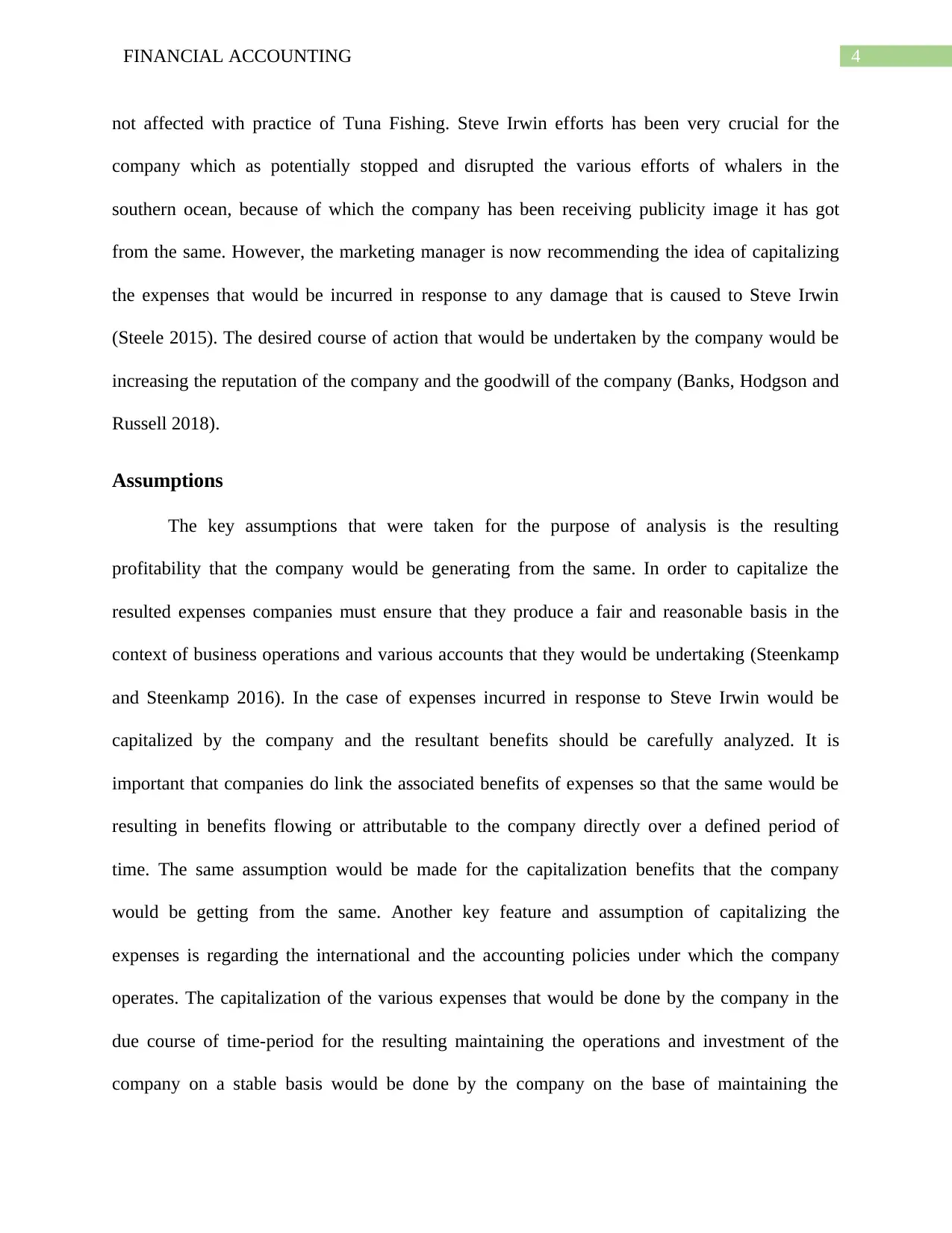
4FINANCIAL ACCOUNTING
not affected with practice of Tuna Fishing. Steve Irwin efforts has been very crucial for the
company which as potentially stopped and disrupted the various efforts of whalers in the
southern ocean, because of which the company has been receiving publicity image it has got
from the same. However, the marketing manager is now recommending the idea of capitalizing
the expenses that would be incurred in response to any damage that is caused to Steve Irwin
(Steele 2015). The desired course of action that would be undertaken by the company would be
increasing the reputation of the company and the goodwill of the company (Banks, Hodgson and
Russell 2018).
Assumptions
The key assumptions that were taken for the purpose of analysis is the resulting
profitability that the company would be generating from the same. In order to capitalize the
resulted expenses companies must ensure that they produce a fair and reasonable basis in the
context of business operations and various accounts that they would be undertaking (Steenkamp
and Steenkamp 2016). In the case of expenses incurred in response to Steve Irwin would be
capitalized by the company and the resultant benefits should be carefully analyzed. It is
important that companies do link the associated benefits of expenses so that the same would be
resulting in benefits flowing or attributable to the company directly over a defined period of
time. The same assumption would be made for the capitalization benefits that the company
would be getting from the same. Another key feature and assumption of capitalizing the
expenses is regarding the international and the accounting policies under which the company
operates. The capitalization of the various expenses that would be done by the company in the
due course of time-period for the resulting maintaining the operations and investment of the
company on a stable basis would be done by the company on the base of maintaining the
not affected with practice of Tuna Fishing. Steve Irwin efforts has been very crucial for the
company which as potentially stopped and disrupted the various efforts of whalers in the
southern ocean, because of which the company has been receiving publicity image it has got
from the same. However, the marketing manager is now recommending the idea of capitalizing
the expenses that would be incurred in response to any damage that is caused to Steve Irwin
(Steele 2015). The desired course of action that would be undertaken by the company would be
increasing the reputation of the company and the goodwill of the company (Banks, Hodgson and
Russell 2018).
Assumptions
The key assumptions that were taken for the purpose of analysis is the resulting
profitability that the company would be generating from the same. In order to capitalize the
resulted expenses companies must ensure that they produce a fair and reasonable basis in the
context of business operations and various accounts that they would be undertaking (Steenkamp
and Steenkamp 2016). In the case of expenses incurred in response to Steve Irwin would be
capitalized by the company and the resultant benefits should be carefully analyzed. It is
important that companies do link the associated benefits of expenses so that the same would be
resulting in benefits flowing or attributable to the company directly over a defined period of
time. The same assumption would be made for the capitalization benefits that the company
would be getting from the same. Another key feature and assumption of capitalizing the
expenses is regarding the international and the accounting policies under which the company
operates. The capitalization of the various expenses that would be done by the company in the
due course of time-period for the resulting maintaining the operations and investment of the
company on a stable basis would be done by the company on the base of maintaining the
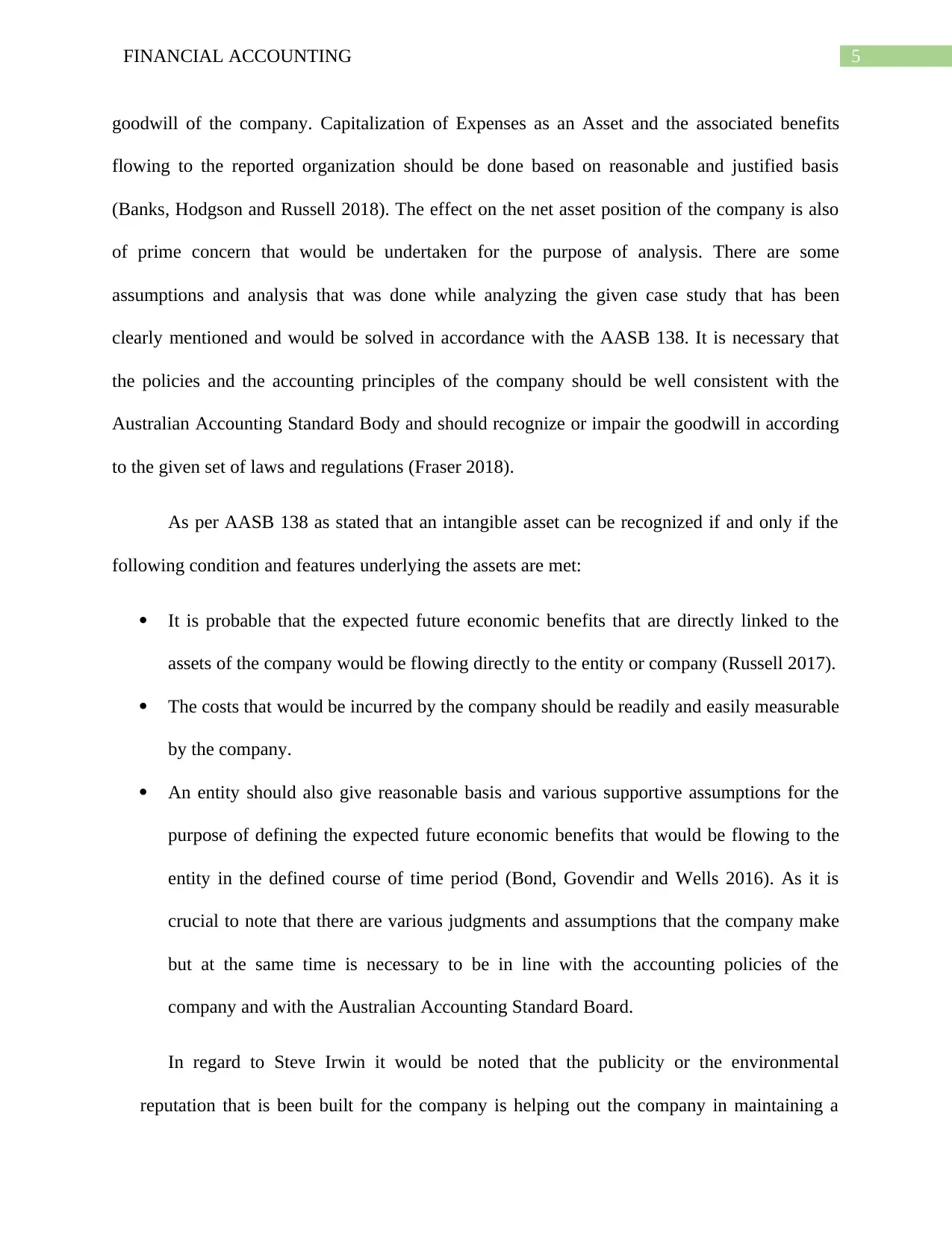
5FINANCIAL ACCOUNTING
goodwill of the company. Capitalization of Expenses as an Asset and the associated benefits
flowing to the reported organization should be done based on reasonable and justified basis
(Banks, Hodgson and Russell 2018). The effect on the net asset position of the company is also
of prime concern that would be undertaken for the purpose of analysis. There are some
assumptions and analysis that was done while analyzing the given case study that has been
clearly mentioned and would be solved in accordance with the AASB 138. It is necessary that
the policies and the accounting principles of the company should be well consistent with the
Australian Accounting Standard Body and should recognize or impair the goodwill in according
to the given set of laws and regulations (Fraser 2018).
As per AASB 138 as stated that an intangible asset can be recognized if and only if the
following condition and features underlying the assets are met:
It is probable that the expected future economic benefits that are directly linked to the
assets of the company would be flowing directly to the entity or company (Russell 2017).
The costs that would be incurred by the company should be readily and easily measurable
by the company.
An entity should also give reasonable basis and various supportive assumptions for the
purpose of defining the expected future economic benefits that would be flowing to the
entity in the defined course of time period (Bond, Govendir and Wells 2016). As it is
crucial to note that there are various judgments and assumptions that the company make
but at the same time is necessary to be in line with the accounting policies of the
company and with the Australian Accounting Standard Board.
In regard to Steve Irwin it would be noted that the publicity or the environmental
reputation that is been built for the company is helping out the company in maintaining a
goodwill of the company. Capitalization of Expenses as an Asset and the associated benefits
flowing to the reported organization should be done based on reasonable and justified basis
(Banks, Hodgson and Russell 2018). The effect on the net asset position of the company is also
of prime concern that would be undertaken for the purpose of analysis. There are some
assumptions and analysis that was done while analyzing the given case study that has been
clearly mentioned and would be solved in accordance with the AASB 138. It is necessary that
the policies and the accounting principles of the company should be well consistent with the
Australian Accounting Standard Body and should recognize or impair the goodwill in according
to the given set of laws and regulations (Fraser 2018).
As per AASB 138 as stated that an intangible asset can be recognized if and only if the
following condition and features underlying the assets are met:
It is probable that the expected future economic benefits that are directly linked to the
assets of the company would be flowing directly to the entity or company (Russell 2017).
The costs that would be incurred by the company should be readily and easily measurable
by the company.
An entity should also give reasonable basis and various supportive assumptions for the
purpose of defining the expected future economic benefits that would be flowing to the
entity in the defined course of time period (Bond, Govendir and Wells 2016). As it is
crucial to note that there are various judgments and assumptions that the company make
but at the same time is necessary to be in line with the accounting policies of the
company and with the Australian Accounting Standard Board.
In regard to Steve Irwin it would be noted that the publicity or the environmental
reputation that is been built for the company is helping out the company in maintaining a
⊘ This is a preview!⊘
Do you want full access?
Subscribe today to unlock all pages.

Trusted by 1+ million students worldwide
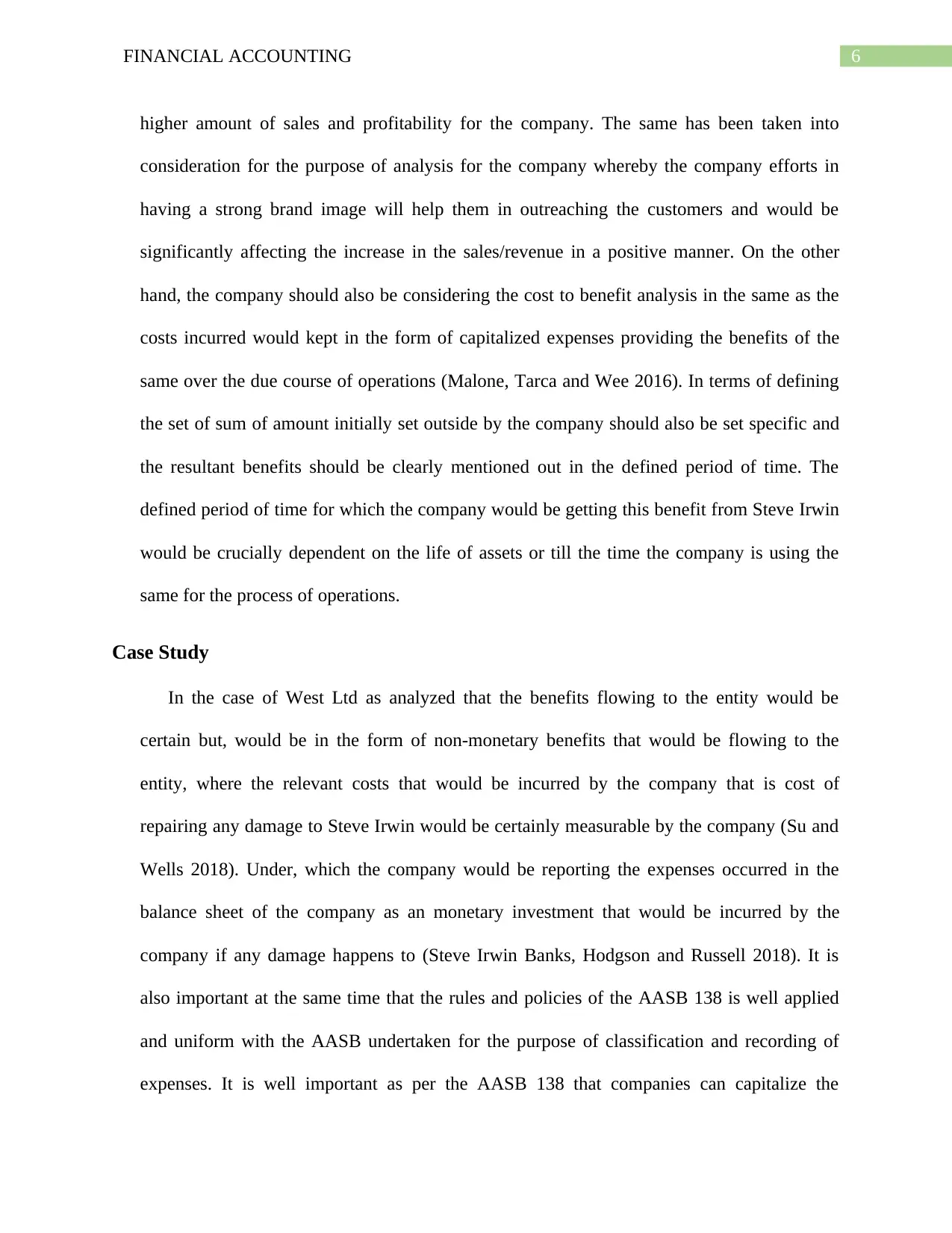
6FINANCIAL ACCOUNTING
higher amount of sales and profitability for the company. The same has been taken into
consideration for the purpose of analysis for the company whereby the company efforts in
having a strong brand image will help them in outreaching the customers and would be
significantly affecting the increase in the sales/revenue in a positive manner. On the other
hand, the company should also be considering the cost to benefit analysis in the same as the
costs incurred would kept in the form of capitalized expenses providing the benefits of the
same over the due course of operations (Malone, Tarca and Wee 2016). In terms of defining
the set of sum of amount initially set outside by the company should also be set specific and
the resultant benefits should be clearly mentioned out in the defined period of time. The
defined period of time for which the company would be getting this benefit from Steve Irwin
would be crucially dependent on the life of assets or till the time the company is using the
same for the process of operations.
Case Study
In the case of West Ltd as analyzed that the benefits flowing to the entity would be
certain but, would be in the form of non-monetary benefits that would be flowing to the
entity, where the relevant costs that would be incurred by the company that is cost of
repairing any damage to Steve Irwin would be certainly measurable by the company (Su and
Wells 2018). Under, which the company would be reporting the expenses occurred in the
balance sheet of the company as an monetary investment that would be incurred by the
company if any damage happens to (Steve Irwin Banks, Hodgson and Russell 2018). It is
also important at the same time that the rules and policies of the AASB 138 is well applied
and uniform with the AASB undertaken for the purpose of classification and recording of
expenses. It is well important as per the AASB 138 that companies can capitalize the
higher amount of sales and profitability for the company. The same has been taken into
consideration for the purpose of analysis for the company whereby the company efforts in
having a strong brand image will help them in outreaching the customers and would be
significantly affecting the increase in the sales/revenue in a positive manner. On the other
hand, the company should also be considering the cost to benefit analysis in the same as the
costs incurred would kept in the form of capitalized expenses providing the benefits of the
same over the due course of operations (Malone, Tarca and Wee 2016). In terms of defining
the set of sum of amount initially set outside by the company should also be set specific and
the resultant benefits should be clearly mentioned out in the defined period of time. The
defined period of time for which the company would be getting this benefit from Steve Irwin
would be crucially dependent on the life of assets or till the time the company is using the
same for the process of operations.
Case Study
In the case of West Ltd as analyzed that the benefits flowing to the entity would be
certain but, would be in the form of non-monetary benefits that would be flowing to the
entity, where the relevant costs that would be incurred by the company that is cost of
repairing any damage to Steve Irwin would be certainly measurable by the company (Su and
Wells 2018). Under, which the company would be reporting the expenses occurred in the
balance sheet of the company as an monetary investment that would be incurred by the
company if any damage happens to (Steve Irwin Banks, Hodgson and Russell 2018). It is
also important at the same time that the rules and policies of the AASB 138 is well applied
and uniform with the AASB undertaken for the purpose of classification and recording of
expenses. It is well important as per the AASB 138 that companies can capitalize the
Paraphrase This Document
Need a fresh take? Get an instant paraphrase of this document with our AI Paraphraser
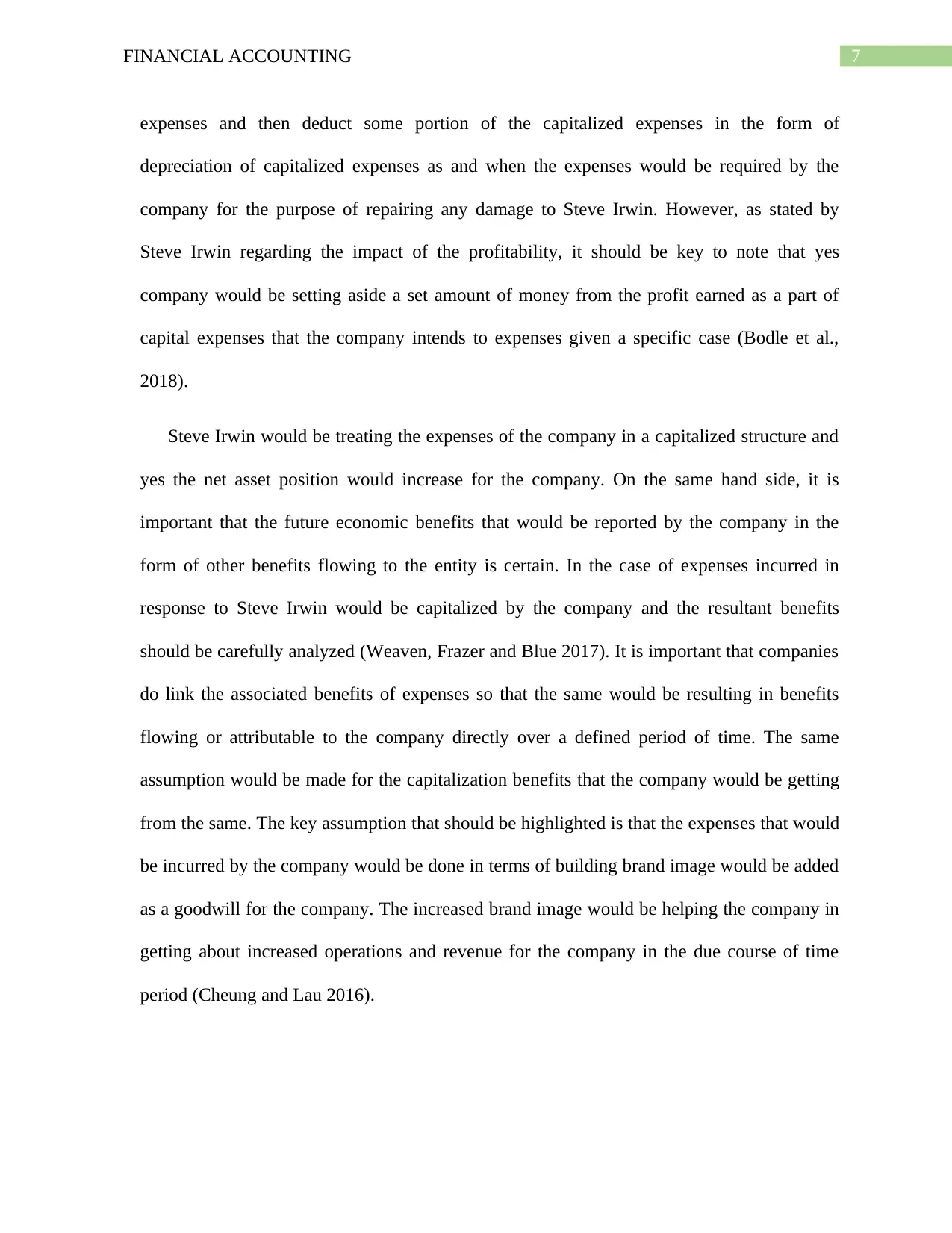
7FINANCIAL ACCOUNTING
expenses and then deduct some portion of the capitalized expenses in the form of
depreciation of capitalized expenses as and when the expenses would be required by the
company for the purpose of repairing any damage to Steve Irwin. However, as stated by
Steve Irwin regarding the impact of the profitability, it should be key to note that yes
company would be setting aside a set amount of money from the profit earned as a part of
capital expenses that the company intends to expenses given a specific case (Bodle et al.,
2018).
Steve Irwin would be treating the expenses of the company in a capitalized structure and
yes the net asset position would increase for the company. On the same hand side, it is
important that the future economic benefits that would be reported by the company in the
form of other benefits flowing to the entity is certain. In the case of expenses incurred in
response to Steve Irwin would be capitalized by the company and the resultant benefits
should be carefully analyzed (Weaven, Frazer and Blue 2017). It is important that companies
do link the associated benefits of expenses so that the same would be resulting in benefits
flowing or attributable to the company directly over a defined period of time. The same
assumption would be made for the capitalization benefits that the company would be getting
from the same. The key assumption that should be highlighted is that the expenses that would
be incurred by the company would be done in terms of building brand image would be added
as a goodwill for the company. The increased brand image would be helping the company in
getting about increased operations and revenue for the company in the due course of time
period (Cheung and Lau 2016).
expenses and then deduct some portion of the capitalized expenses in the form of
depreciation of capitalized expenses as and when the expenses would be required by the
company for the purpose of repairing any damage to Steve Irwin. However, as stated by
Steve Irwin regarding the impact of the profitability, it should be key to note that yes
company would be setting aside a set amount of money from the profit earned as a part of
capital expenses that the company intends to expenses given a specific case (Bodle et al.,
2018).
Steve Irwin would be treating the expenses of the company in a capitalized structure and
yes the net asset position would increase for the company. On the same hand side, it is
important that the future economic benefits that would be reported by the company in the
form of other benefits flowing to the entity is certain. In the case of expenses incurred in
response to Steve Irwin would be capitalized by the company and the resultant benefits
should be carefully analyzed (Weaven, Frazer and Blue 2017). It is important that companies
do link the associated benefits of expenses so that the same would be resulting in benefits
flowing or attributable to the company directly over a defined period of time. The same
assumption would be made for the capitalization benefits that the company would be getting
from the same. The key assumption that should be highlighted is that the expenses that would
be incurred by the company would be done in terms of building brand image would be added
as a goodwill for the company. The increased brand image would be helping the company in
getting about increased operations and revenue for the company in the due course of time
period (Cheung and Lau 2016).
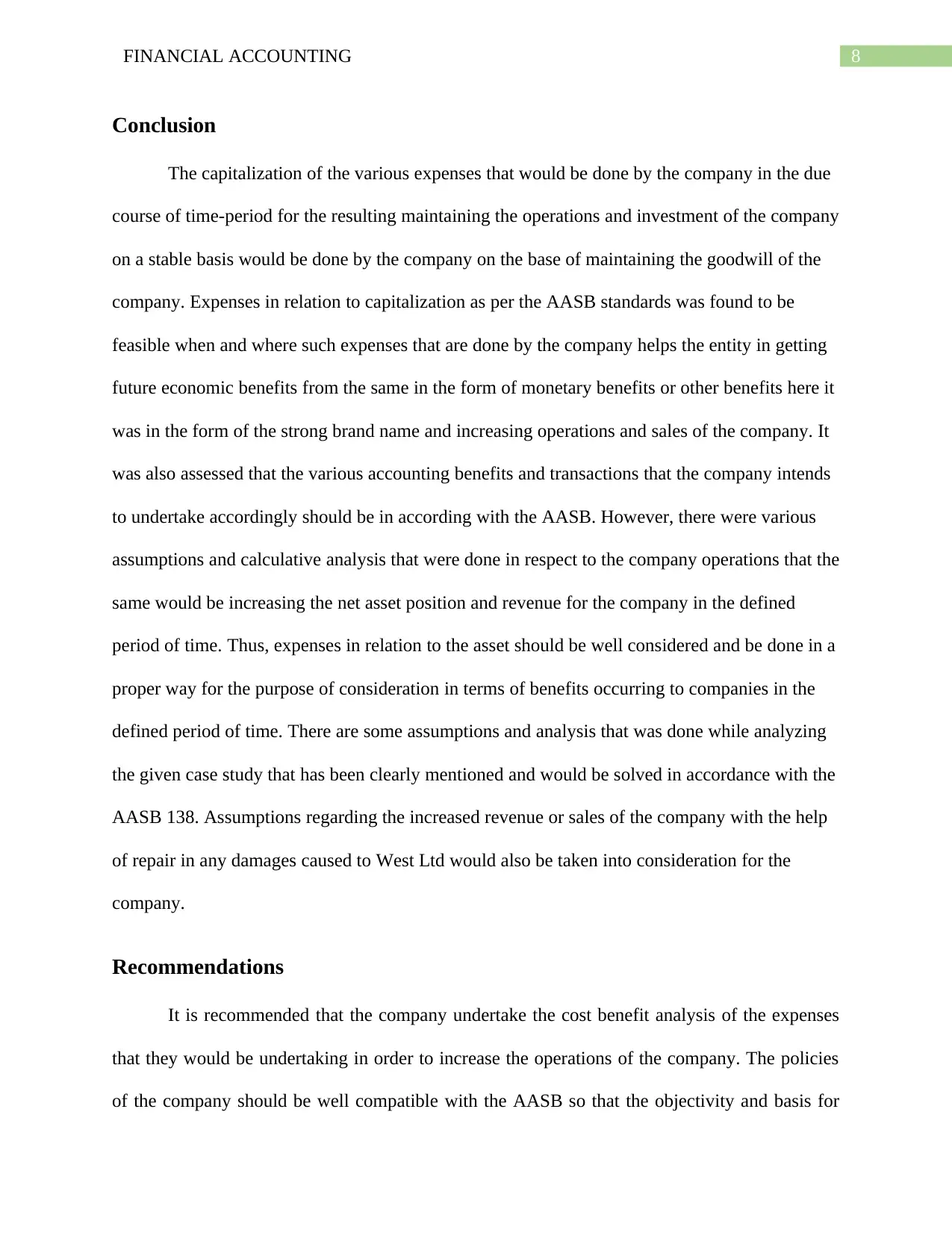
8FINANCIAL ACCOUNTING
Conclusion
The capitalization of the various expenses that would be done by the company in the due
course of time-period for the resulting maintaining the operations and investment of the company
on a stable basis would be done by the company on the base of maintaining the goodwill of the
company. Expenses in relation to capitalization as per the AASB standards was found to be
feasible when and where such expenses that are done by the company helps the entity in getting
future economic benefits from the same in the form of monetary benefits or other benefits here it
was in the form of the strong brand name and increasing operations and sales of the company. It
was also assessed that the various accounting benefits and transactions that the company intends
to undertake accordingly should be in according with the AASB. However, there were various
assumptions and calculative analysis that were done in respect to the company operations that the
same would be increasing the net asset position and revenue for the company in the defined
period of time. Thus, expenses in relation to the asset should be well considered and be done in a
proper way for the purpose of consideration in terms of benefits occurring to companies in the
defined period of time. There are some assumptions and analysis that was done while analyzing
the given case study that has been clearly mentioned and would be solved in accordance with the
AASB 138. Assumptions regarding the increased revenue or sales of the company with the help
of repair in any damages caused to West Ltd would also be taken into consideration for the
company.
Recommendations
It is recommended that the company undertake the cost benefit analysis of the expenses
that they would be undertaking in order to increase the operations of the company. The policies
of the company should be well compatible with the AASB so that the objectivity and basis for
Conclusion
The capitalization of the various expenses that would be done by the company in the due
course of time-period for the resulting maintaining the operations and investment of the company
on a stable basis would be done by the company on the base of maintaining the goodwill of the
company. Expenses in relation to capitalization as per the AASB standards was found to be
feasible when and where such expenses that are done by the company helps the entity in getting
future economic benefits from the same in the form of monetary benefits or other benefits here it
was in the form of the strong brand name and increasing operations and sales of the company. It
was also assessed that the various accounting benefits and transactions that the company intends
to undertake accordingly should be in according with the AASB. However, there were various
assumptions and calculative analysis that were done in respect to the company operations that the
same would be increasing the net asset position and revenue for the company in the defined
period of time. Thus, expenses in relation to the asset should be well considered and be done in a
proper way for the purpose of consideration in terms of benefits occurring to companies in the
defined period of time. There are some assumptions and analysis that was done while analyzing
the given case study that has been clearly mentioned and would be solved in accordance with the
AASB 138. Assumptions regarding the increased revenue or sales of the company with the help
of repair in any damages caused to West Ltd would also be taken into consideration for the
company.
Recommendations
It is recommended that the company undertake the cost benefit analysis of the expenses
that they would be undertaking in order to increase the operations of the company. The policies
of the company should be well compatible with the AASB so that the objectivity and basis for
⊘ This is a preview!⊘
Do you want full access?
Subscribe today to unlock all pages.

Trusted by 1+ million students worldwide
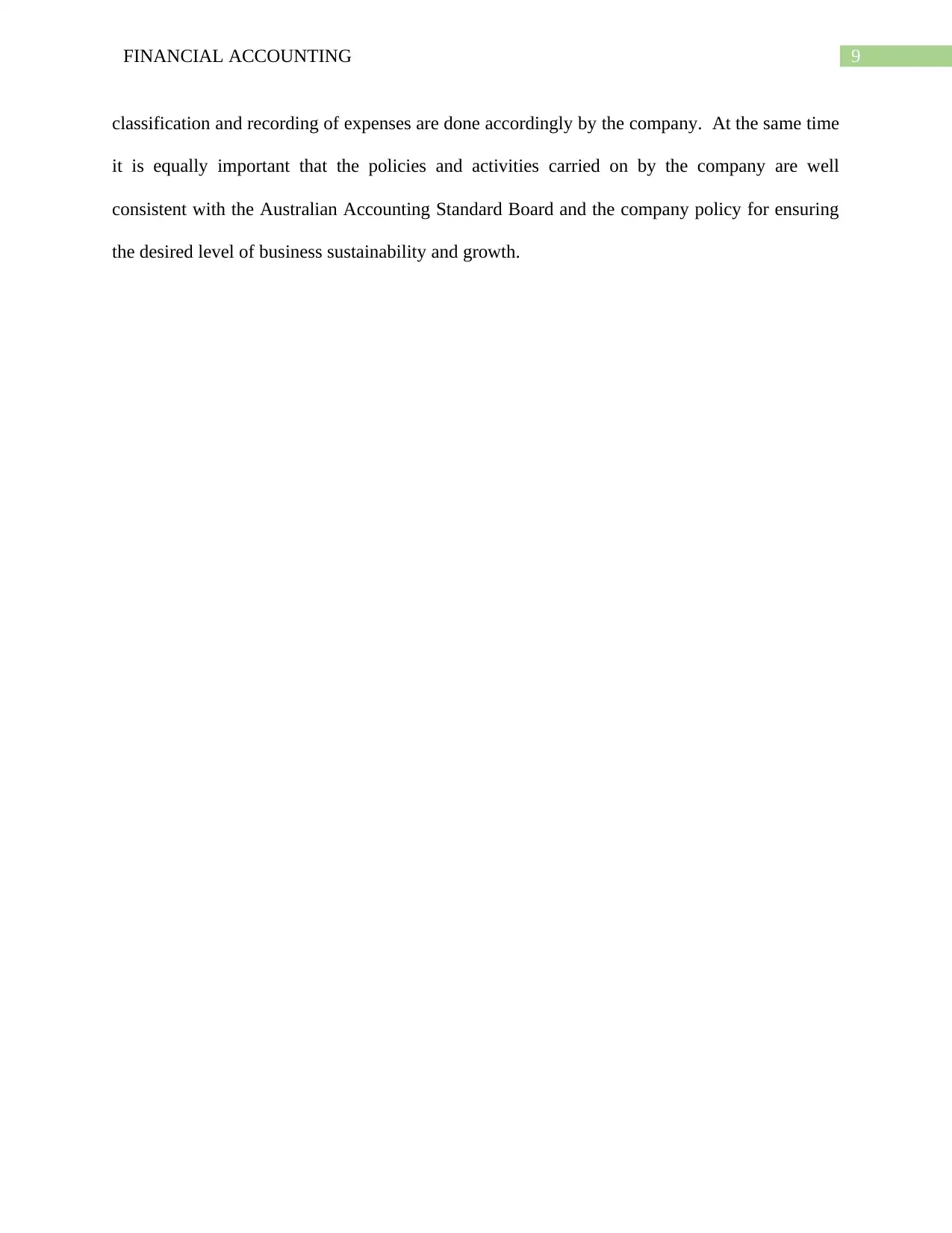
9FINANCIAL ACCOUNTING
classification and recording of expenses are done accordingly by the company. At the same time
it is equally important that the policies and activities carried on by the company are well
consistent with the Australian Accounting Standard Board and the company policy for ensuring
the desired level of business sustainability and growth.
classification and recording of expenses are done accordingly by the company. At the same time
it is equally important that the policies and activities carried on by the company are well
consistent with the Australian Accounting Standard Board and the company policy for ensuring
the desired level of business sustainability and growth.
Paraphrase This Document
Need a fresh take? Get an instant paraphrase of this document with our AI Paraphraser
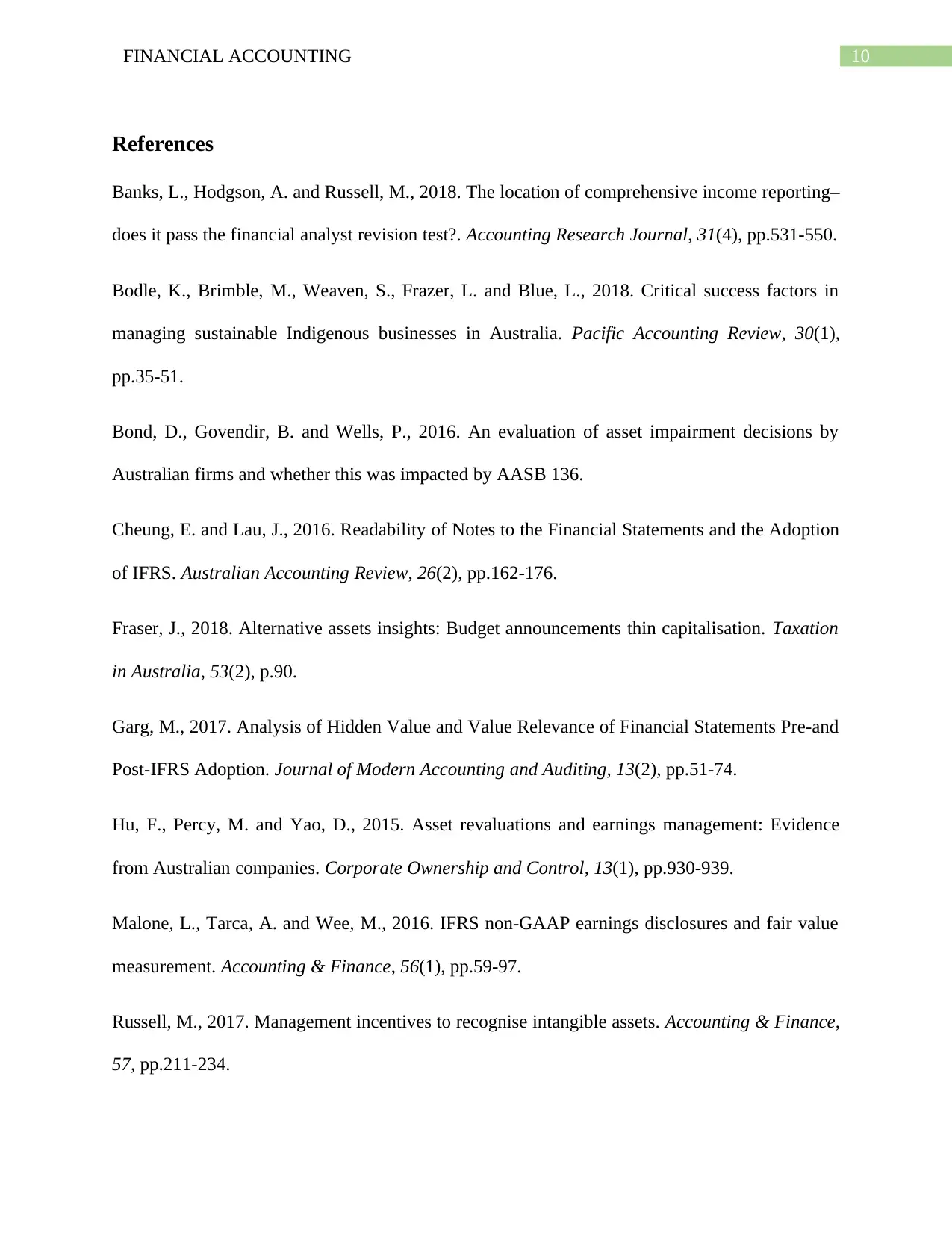
10FINANCIAL ACCOUNTING
References
Banks, L., Hodgson, A. and Russell, M., 2018. The location of comprehensive income reporting–
does it pass the financial analyst revision test?. Accounting Research Journal, 31(4), pp.531-550.
Bodle, K., Brimble, M., Weaven, S., Frazer, L. and Blue, L., 2018. Critical success factors in
managing sustainable Indigenous businesses in Australia. Pacific Accounting Review, 30(1),
pp.35-51.
Bond, D., Govendir, B. and Wells, P., 2016. An evaluation of asset impairment decisions by
Australian firms and whether this was impacted by AASB 136.
Cheung, E. and Lau, J., 2016. Readability of Notes to the Financial Statements and the Adoption
of IFRS. Australian Accounting Review, 26(2), pp.162-176.
Fraser, J., 2018. Alternative assets insights: Budget announcements thin capitalisation. Taxation
in Australia, 53(2), p.90.
Garg, M., 2017. Analysis of Hidden Value and Value Relevance of Financial Statements Pre-and
Post-IFRS Adoption. Journal of Modern Accounting and Auditing, 13(2), pp.51-74.
Hu, F., Percy, M. and Yao, D., 2015. Asset revaluations and earnings management: Evidence
from Australian companies. Corporate Ownership and Control, 13(1), pp.930-939.
Malone, L., Tarca, A. and Wee, M., 2016. IFRS non‐GAAP earnings disclosures and fair value
measurement. Accounting & Finance, 56(1), pp.59-97.
Russell, M., 2017. Management incentives to recognise intangible assets. Accounting & Finance,
57, pp.211-234.
References
Banks, L., Hodgson, A. and Russell, M., 2018. The location of comprehensive income reporting–
does it pass the financial analyst revision test?. Accounting Research Journal, 31(4), pp.531-550.
Bodle, K., Brimble, M., Weaven, S., Frazer, L. and Blue, L., 2018. Critical success factors in
managing sustainable Indigenous businesses in Australia. Pacific Accounting Review, 30(1),
pp.35-51.
Bond, D., Govendir, B. and Wells, P., 2016. An evaluation of asset impairment decisions by
Australian firms and whether this was impacted by AASB 136.
Cheung, E. and Lau, J., 2016. Readability of Notes to the Financial Statements and the Adoption
of IFRS. Australian Accounting Review, 26(2), pp.162-176.
Fraser, J., 2018. Alternative assets insights: Budget announcements thin capitalisation. Taxation
in Australia, 53(2), p.90.
Garg, M., 2017. Analysis of Hidden Value and Value Relevance of Financial Statements Pre-and
Post-IFRS Adoption. Journal of Modern Accounting and Auditing, 13(2), pp.51-74.
Hu, F., Percy, M. and Yao, D., 2015. Asset revaluations and earnings management: Evidence
from Australian companies. Corporate Ownership and Control, 13(1), pp.930-939.
Malone, L., Tarca, A. and Wee, M., 2016. IFRS non‐GAAP earnings disclosures and fair value
measurement. Accounting & Finance, 56(1), pp.59-97.
Russell, M., 2017. Management incentives to recognise intangible assets. Accounting & Finance,
57, pp.211-234.
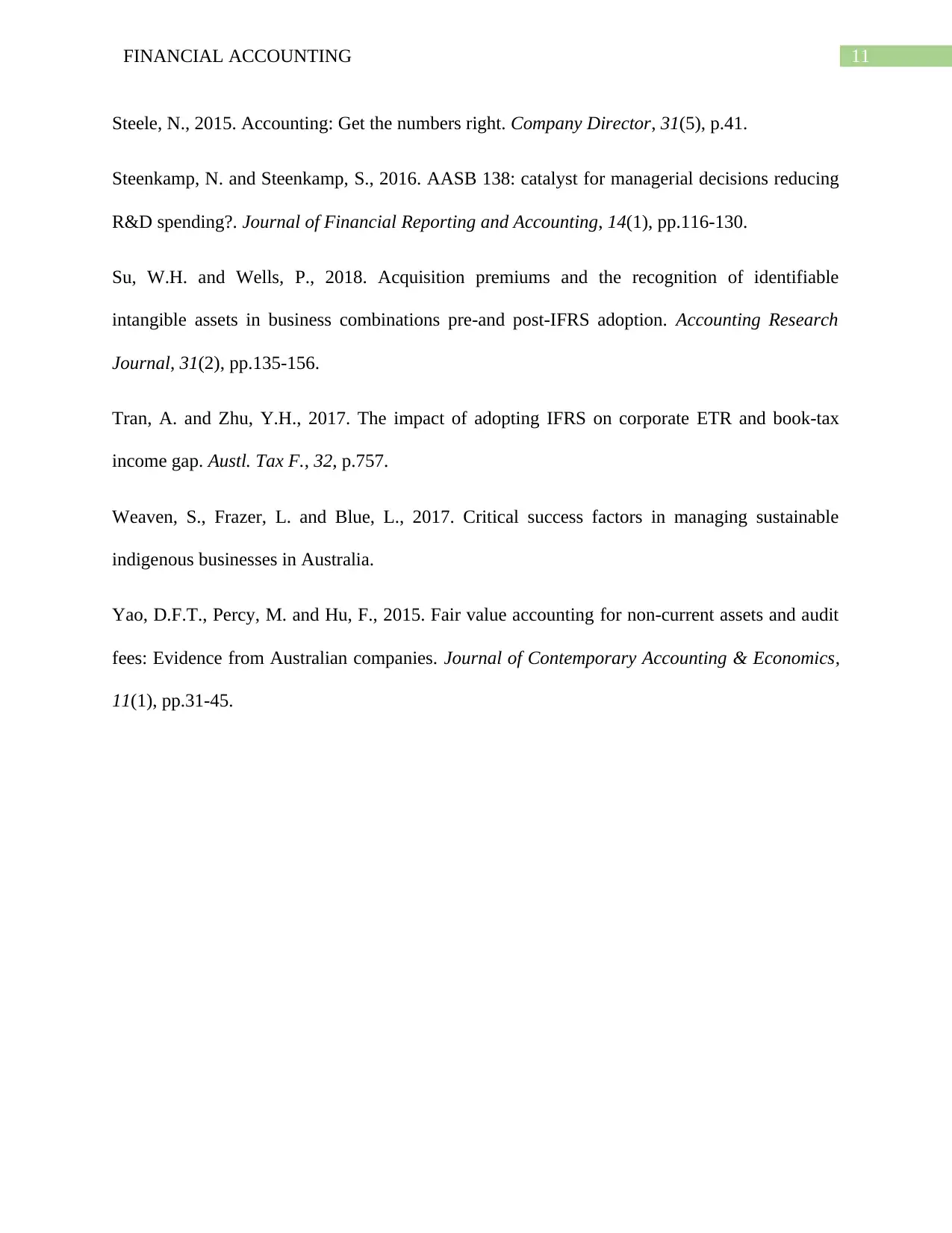
11FINANCIAL ACCOUNTING
Steele, N., 2015. Accounting: Get the numbers right. Company Director, 31(5), p.41.
Steenkamp, N. and Steenkamp, S., 2016. AASB 138: catalyst for managerial decisions reducing
R&D spending?. Journal of Financial Reporting and Accounting, 14(1), pp.116-130.
Su, W.H. and Wells, P., 2018. Acquisition premiums and the recognition of identifiable
intangible assets in business combinations pre-and post-IFRS adoption. Accounting Research
Journal, 31(2), pp.135-156.
Tran, A. and Zhu, Y.H., 2017. The impact of adopting IFRS on corporate ETR and book-tax
income gap. Austl. Tax F., 32, p.757.
Weaven, S., Frazer, L. and Blue, L., 2017. Critical success factors in managing sustainable
indigenous businesses in Australia.
Yao, D.F.T., Percy, M. and Hu, F., 2015. Fair value accounting for non-current assets and audit
fees: Evidence from Australian companies. Journal of Contemporary Accounting & Economics,
11(1), pp.31-45.
Steele, N., 2015. Accounting: Get the numbers right. Company Director, 31(5), p.41.
Steenkamp, N. and Steenkamp, S., 2016. AASB 138: catalyst for managerial decisions reducing
R&D spending?. Journal of Financial Reporting and Accounting, 14(1), pp.116-130.
Su, W.H. and Wells, P., 2018. Acquisition premiums and the recognition of identifiable
intangible assets in business combinations pre-and post-IFRS adoption. Accounting Research
Journal, 31(2), pp.135-156.
Tran, A. and Zhu, Y.H., 2017. The impact of adopting IFRS on corporate ETR and book-tax
income gap. Austl. Tax F., 32, p.757.
Weaven, S., Frazer, L. and Blue, L., 2017. Critical success factors in managing sustainable
indigenous businesses in Australia.
Yao, D.F.T., Percy, M. and Hu, F., 2015. Fair value accounting for non-current assets and audit
fees: Evidence from Australian companies. Journal of Contemporary Accounting & Economics,
11(1), pp.31-45.
⊘ This is a preview!⊘
Do you want full access?
Subscribe today to unlock all pages.

Trusted by 1+ million students worldwide
1 out of 12
Related Documents
Your All-in-One AI-Powered Toolkit for Academic Success.
+13062052269
info@desklib.com
Available 24*7 on WhatsApp / Email
![[object Object]](/_next/static/media/star-bottom.7253800d.svg)
Unlock your academic potential
Copyright © 2020–2025 A2Z Services. All Rights Reserved. Developed and managed by ZUCOL.





